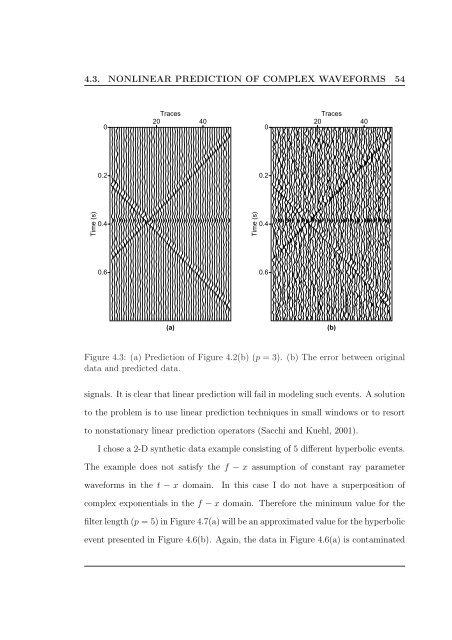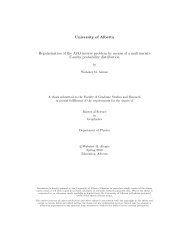Soner Bekleric Title of Thesis: Nonlinear Prediction via Volterra Ser
Soner Bekleric Title of Thesis: Nonlinear Prediction via Volterra Ser
Soner Bekleric Title of Thesis: Nonlinear Prediction via Volterra Ser
You also want an ePaper? Increase the reach of your titles
YUMPU automatically turns print PDFs into web optimized ePapers that Google loves.
4.3. NONLINEAR PREDICTION OF COMPLEX WAVEFORMS 54<br />
Time (s)<br />
0<br />
0.2<br />
0.4<br />
0.6<br />
Traces<br />
20 40<br />
(a)<br />
Time (s)<br />
0<br />
0.2<br />
0.4<br />
0.6<br />
Traces<br />
20 40<br />
Figure 4.3: (a) <strong>Prediction</strong> <strong>of</strong> Figure 4.2(b) (p = 3). (b) The error between original<br />
data and predicted data.<br />
signals. It is clear that linear prediction will fail in modeling such events. A solution<br />
to the problem is to use linear prediction techniques in small windows or to resort<br />
to nonstationary linear prediction operators (Sacchi and Kuehl, 2001).<br />
I chose a 2-D synthetic data example consisting <strong>of</strong> 5 different hyperbolic events.<br />
The example does not satisfy the f − x assumption <strong>of</strong> constant ray parameter<br />
waveforms in the t − x domain. In this case I do not have a superposition <strong>of</strong><br />
complex exponentials in the f − x domain. Therefore the minimum value for the<br />
filter length (p = 5) in Figure 4.7(a) will be an approximated value for the hyperbolic<br />
event presented in Figure 4.6(b). Again, the data in Figure 4.6(a) is contaminated<br />
(b)









